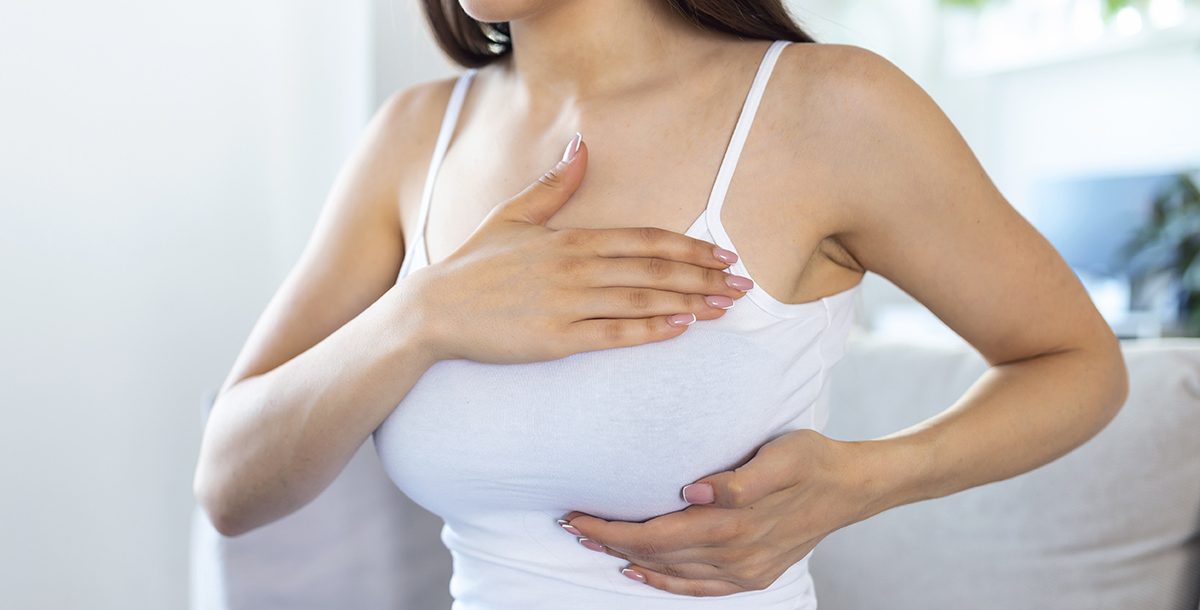A breast lump is a growth of tissue that develops within your breast. Finding a lump in your breast can be frightening and provoke anxiety. Most breast lumps aren't dangerous, but it's important to see your doctor to have them evaluated promptly.
What are the symptoms of Breast Lump?
If you have an underlying breast condition, you might notice changes in how your breasts normally feel, such as:
- A round, smooth and firm breast lump
- A large, solid-feeling lump that moves easily under your skin
- A hard, irregular-shaped breast lump
- Skin redness or dimpling like an orange
- Changes in breast size or shape
- Fluid leaking from your nipple
Causes:
Lumps in the breasts can have lots of different causes. They're often caused by something harmless like a non-cancerous tissue growth (fibroadenoma) or a build-up of fluid (breast cyst).Sometimes, a breast lump can be a sign of something serious like breast cancer. Breast lumps are very common. It is important that you regularly check your own breasts for breast lumps. If you notice a lump, there is no need to panic, but it is also important that you do not ignore or postpone getting care and treatment either. Be sure to seek medical attention if you notice a breast lump—call your doctor within a few days so that you can be given a prompt appointment for imaging or an office visit.
Even benign growths generally need to be removed, treated, or carefully observed, so you will need medical attention whether you have breast cancer or not. Also, once any dehydration is treated with drinks, encourage your child to eat as normally as possible.
When to see a doctor?
- a lump in your breast or armpit.
- any other unusual changes in your breasts – such as the nipple turning inwards, dimpled skin or blood stained nipple discharge.
چھاتی کا لمپس
چھاتی کا لمپس ٹشووں کی نشوونما ہے جو آپ کے چھاتی کے اندر تیار ہوتی ہے۔ آپ کے چھاتی میں گانٹھ کا پتہ لگانا خوفناک اور پریشان کن ہو سکتا ہے۔ زیادہ تر چھاتی کے لمپس خطرناک نہیں ہوتے ہیں ، لیکن یہ ضروری ہے کہ اپنے ڈاکٹر سے فوری رجوع کیا جاے۔
علامات
اگر آپ کی چھاتی میں مسلہ ہوتا ہے تو ، آپ کو تبدیلیاں محسوس ہوسکتی ہیں کہ آپ کے سینوں کو عام طور پر کیسا محسوس ہوتا ہے ، جیسے:
ایک گول ، ہموار اور مضبوط چھاتی کا لمپس۔
ایک بڑا ، ٹھوس احساس والا لمپس جو آپ کی جلد کے نیچے آسانی سے حرکت کرتا ہے۔
سخت ، فاسد شکل کے چھاتی کا لمپس۔
سنتری کی طرح جلد کی لالی یا دھیما پن۔
چھاتی کے سائز یا شکل میں تبدیلی۔
آپ کے نپل سے سیال نکلنا۔
اسباب:
سینوں میں لمپس کی بہت سی مختلف وجوہات ہوسکتی ہیں۔ یہ اکثر بغیر کسی نقصان دہ چیز کی وجہ سے ہوتے ہیں جیسے غیر کینسر کے بافتوں کی نشوونما (فائبروڈینوما) یا سیال (چھاتی کا سسٹ) کی تشکیل ۔کبھی ، چھاتی کا لمپس چھاتی کے کینسر جیسی سنگین چیز کی علامت ہوسکتی ہے۔ چھاتی کے لمپس بہت عام ہیں۔ یہ ضروری ہے کہ آپ چھاتی کے لمپس کے لئے باقاعدگی سے اپنے سینوں کی جانچ کریں۔ اگر آپ کو ایک لمپس محسوس ہوتا ہے تو گھبرانے کی ضرورت نہیں ہے ، لیکن یہ بھی ضروری ہے کہ آپ دیکھ بھال اور علاج معالجے کو نظرانداز یا ملتوی نہ کریں۔ اگر آپ کو چھاتی کا لمپس نظر آرہا ہے تو طبی امداد حاصل کرنا یقینی بنائیں اور کچھ دن کے اندر ہی اپنے ڈاکٹر سے رجوع کریں تاکہ آپ سے امیجنگ یا آفس کے دورے کے لئے فوری طور پر ملاقات کی جاسکے۔
یہاں تک کہ سومی نشونما (benign growth) کو بھی نکلوانے، علاج اور غور سے دیکھنے کی ضرورت ہوتی ہے اور یہ دیکھنا ضروری ہے کے یہ لمپس چاھاتی کا کینسر نہ ہو۔
ڈاکٹر سے کب ملنا ہے
آپ کے چھاتی یا بغلوں میں ایک لمپس ہو
آپ کے سینوں میں کوئی دوسری غیر معمولی تبدیلیاں- جیسے نپل اندر کی طرف موڑنا ، ہلکی جلد یا نپل سے خون خارج ہونا۔
Doctors to consult (Gynecologist):
Dr Asma Sajid, Dr Fatima Akhtar Naseem, Dr Shumaila Raza
Note: Click the Doctor's name to make an appointment.
Reference:
https://www.mayoclinic.org/diseases-conditions/suspicious-breast-lumps/symptoms-causes/syc-20352786
https://www.nhs.uk/conditions/breast-lump
https://www.radiologyinfo.org/en/info/breastlumps
https://www.verywellhealth.com/understanding-breast-lumps-both-benign-and-cancerous-430415

